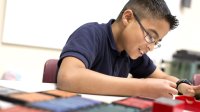Genius Hour in Elementary School
A teacher shares what she did and what she learned when she implemented Genius Hour in her fifth-grade class.
Your content has been saved!
Go to My Saved Content.We’ve all heard legends of Google employees being able to spend 20 percent of their workweek exploring topics of their choosing. Some of our favorite apps were born in this innovative venture.
Educators know a good idea when we see one (even if Google eventually ended the program). We want that vibrant creativity pulsing through our classrooms. We can visualize the end, filled with projects in which our students have connected with experts, filled journals with intelligent thinking, and explored with curiosity. How do we get from this euphoric idea to a classroom reality?
My first year of Genius Hour in my fifth-grade classroom was a huge success. I gave students one hour each week to study any subject of their choosing. They chose subjects I could not have predicted: the architecture of the Czech Republic, blade forging, gender issues in the media. They used a plethora of technology and three-dimensional models. Working alongside my students, my topic was “How to Implement Genius Hour in the Classroom.” Our year was successful but also flawed, with room for improvement and refinement.
I am definitely the big-idea, hippie-style teacher, so I developed a scaffolded, organized system that helped my students yet still encouraged the creative process. We began with four weeks of exploring ideas, spent three weeks narrowing topics, and then worked most of the year learning and creating, until the last four weeks, when we polished and presented our learning.
Time
While time is difficult for teachers to give up, this is key for creativity and quality. There was the time I saw Zech playing games and wanted to redirect his attention. Instead I said, “So, what are you working on?” He proceeded to explain the type of computer coding language he was researching and how it compared to another language. His project was to compare coding languages to find the easiest for kids to use in designing video games. Even though it was part of his research, I would continue to worry when I saw him playing games.
Time is essential for creativity; however, deadlines are also a reality. To help my students take on such a large project, I set up mini-project deadlines. Every five weeks, students needed to turn in a mini-project. Every project was different, with its own possibilities, so each student chose their own mini-project: PowerPoint, 3D model, background research, QR codes, creating a logo or a video, etc. Learning how to chunk a large project is a powerful skill. I kept a “status of the class” chart in my notebook to help me track their progress.
Reflection
Teachers know the value of reflection, but getting students engaged in authentic reflection is an art. Students kept a spiral notebook for journaling. The notebook housed their brainstorming, thinking about their project, vocabulary, research notes, data, interview notes, and works cited. In reality, not all students had awesome notebooks. This is one area I will focus on this year. I will structure time to reflect.
Our reflection also took place online. I posted questions or thinking prompts periodically:
- List your mini-project ideas.
- What are your Genius Hour challenges?
- How are you using outside sources to add depth to your project?
- What technology will you use to showcase your project?
- How do you organize your vocabulary?
Collaboration
Genius Hour was a socially academic part of our classroom. As the facilitator, I organized partner and group chats. Walking into this activity, you would hear 11-year-olds intelligently discussing their status, struggles, and possibilities.
Some students were more adept in some areas. One student, Aiden, was brilliant with big ideas but couldn’t complete any work. Aspen, on the other hand, could run a small company. I paired them up and called Aspen a “consultant.” It wasn’t long before Aiden had his project moving along.
As we moved into the polishing stage, students worked together and swapped expertise. Skills like lettering titles, turning a video link into a QR code, and using keyboard shortcuts in typing were swapped throughout the classroom. This workshop environment happened authentically, but this year I will organize it by having a skill-sharing poster where students can log skills they have.
Sharing
From the first day’s introduction of Genius Hour, my students knew that the final product would be shared with the world. We knew that would look different for every student. Some might start a blog, some would visit a classroom, and others would submit ideas to publications. I hosted an evening when students could showcase their projects for their peers and families. Sharing gave their year’s worth of work meaning.
Genius Hour could be adapted to any grade level or student type. This year I plan on expanding it to my special education class. The vibrant creativity pulls students into the learning process and makes school a place they want to be—and that’s not exclusive to one age or type of student.
